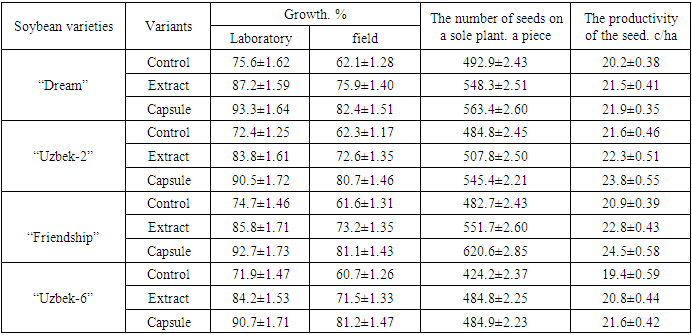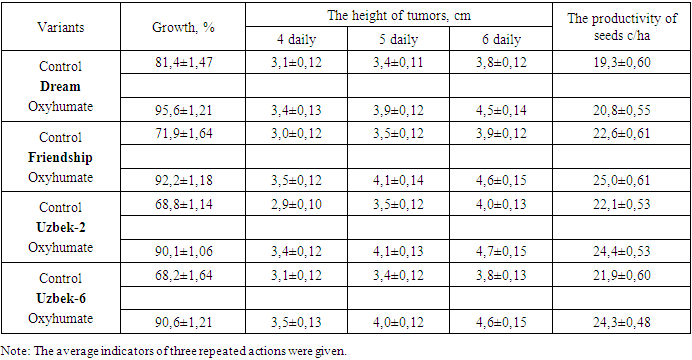-
Paper Information
- Paper Submission
-
Journal Information
- About This Journal
- Editorial Board
- Current Issue
- Archive
- Author Guidelines
- Contact Us
International Journal of Genetic Engineering
p-ISSN: 2167-7239 e-ISSN: 2167-7220
2019; 7(2): 25-27
doi:10.5923/j.ijge.20190702.02

The Effect of Processing Soybean Seeds before the Cultivation to the Development, Growth and Yield of the Plants
Dilorom Annamuratova1, Khurshida Salavatova1, Zayniddin Kodirov2
1Department of Soil Science Chair, Faculty of Natural Sciences, Urgench State University, Urgench, Uzbekistan
2Department of Irrigation and Melioration, Faculty of Hydro Melioration, Tashkent Institute of Irrigation and Agricultural Mechanization Engineers Bukhara Branch, Bukhara, Uzbekistan
Correspondence to: Dilorom Annamuratova, Department of Soil Science Chair, Faculty of Natural Sciences, Urgench State University, Urgench, Uzbekistan.
| Email: |  |
Copyright © 2019 The Author(s). Published by Scientific & Academic Publishing.
This work is licensed under the Creative Commons Attribution International License (CC BY).
http://creativecommons.org/licenses/by/4.0/

The effect of processing soybean seeds before the cultivation to the development, growth and yield of the plants was revealed. The main ways to increase productivity of agricultural crops and the amount of quality products are to rice the productivity of existing native crops by means of the combined factors and to accustom new promising varieties and sorts of plants to the local soil and climatic conditions. The resistance of plants to the effects of outer environmental factors depends on their genotype, but they are not always sufficiently used. Therefore, the data of the specific plant species and varieties on development, growth intensity and yield is diverse. It is necessary to increase durability of promising agricultural crops in various ways, in the process of promoting them in new regions. Bio ecological and morpho-physiologic features of the soybean varieties were studied in the soil-climate conditions of Khorezm region. The effects of oxyhumate, liquor ice extracts and capsulation to the growth and yield of the soybean seeds varieties were determined.
Keywords: Soybean varieties, Growth, Development, Periods of ontogenesis, Productivity, Extract, Capsule, The number of sееds
Cite this paper: Dilorom Annamuratova, Khurshida Salavatova, Zayniddin Kodirov, The Effect of Processing Soybean Seeds before the Cultivation to the Development, Growth and Yield of the Plants, International Journal of Genetic Engineering, Vol. 7 No. 2, 2019, pp. 25-27. doi: 10.5923/j.ijge.20190702.02.
1. Introduction
- The most effective measurement among different agro-technical ones is the method of seed processing before sowing according to the indicator of “expense of additional yield”. Therefore, there are various methods of processing seeds before sowing.Considering above-mentioned facts, some researches are organized in different ways of processing them before sowing seeds in cultivating promising agricultural crops, including soybean varieties, in the soil-climatic conditions of the Khorezm oasis.
2. Materials and Methods
- Before sowing seeds of different plants, the usage of phytoohormones: solutions of auxins, gibberellins and cytokines stimulates the resistance of plants to various diseases and extreme factors (including soil salinization).Medications of phytogormones and various chemical stimulants are expensive. In the Aral Sea region, Glycirriza glabra L. (liquorice) is very common. Its root contains a large amount of glycyrrhizic acid (from 6% to 23% by weight of the root dry matter), it means that the more is the soil salinity, the higher is the amount of glycerin acids [9]. Glycyrrhizic acid is used in the manufacture of various medications. In recent years, it has been found out that glycyrrhizic acid has a phyto-hormonal effects to growth and development of plants, likeauxins and gibberellins [10,11].The 10-7М concentration of glycyrrhizic acid, like indolyl acetic acid-IUK(10-4М) increases growth of low-fruitful seeds, enlarges the tumors formed from highly productive seeds, accelerates the growth of wheat koleophtia, helps pea leaves to grow out sooner and increases the mass of the pea leaves [6].Glycyrrhizic acid also affects like the phytogormones (auxin, gibberellin). In experiments with 3N-IUK ва 3N-gibberellinic acid on cotton plants, it was determined that glycyrrhizic acidassociates with these phytohormones receptors and activates them.Therefore, the idea of using juice extract (boiling) from the liquorice root as a stimulant for different plants was born.The 10-3-10-4M concentration of glycyrrhizic acid contains the ability to form gels, therefore, it was used to capsulate the seeds. The high concentrations of calcium in soils increases the durability of plants to salinity, therefore, the seeds are encapsulated by adding lime to the juice extract. In this way, the sowing of cotton seeds has been processed before sowing, and their resistance to soil salinity has been increased [7,11].Based on the above, experiments have been carried out to increase soil salinity resistance. In the experiments, soybean seeds with low fruitfulness were used. The experiments were conducted in 3 variants: In variant 1, soybean seeds were soaked in distilled water for 3 hours and then sown in containers. In variant 2 soybean seeds were sown after soaking them in liquorice extract for 2 hours. In variant 3, the seeds were planted in a capsule prepared from the liquorice extract and then sown. The results are shown in Table 1.The resistance of studied soybean seeds to the soil salinity will increase, if if they are soaked in extracts of liquorice and then capsulated before planting. The growth of soybean seeds’ varieties increases in lab and field conditions. Plants from such sown areas also grow well, develop and increase their yield (Table 1).
|
|
3. Results and Discussion
- According to experimental results, soybean varieties studied by 0.01% of oxyhumate concentration will increase sharply in the temperature of 15°C (20-30%). The intensity of growth of soybean tumors also accelerates due to oxyhumate. The effect of the oxyhumate on growth and development of soybean varieties as a stimulant really developed during the early stages of plant growth [1].The molecular mechanisms of the increase in susceptibility and growth rates of soybean seeds studied under the influence of physiologically active gum acids and other compounds in the oxyhumate cannot be clearly clarified. It is known from the existing literature that oxyhumate increases phospholipase D enzyme activity [2], enhances the synthesis of chlorophyll, increases photosynthetic productivity, and optimizes mineral nutrition [3,5,8].
4. Conclusions
- According to the analysis of scientific literature on tempering seeds in different ways before sowing, the response reactions of cells to the stressors are general and non-specific, and the tempering one factor of the plant increases the resistance of other factors, respectively. For example, to rice the resistance of seeds to soil salinity increases their resistance to droughts, diseases and pests.It should be noted that, when processing the plant under the influence of a certain factor, the amount of the factor effect should not exceed the potential for plant endurance. Various stressors (disadvantages) cause chained nonspecific reactions in the plant cell. The membrane in the first ring of this chain increases their ionization ability, and the calcium ions move from different cells to cytosol. The increase in calcium ions in cytoplasm shows the activity of many calcium-dependent processes and enzymes, especially enzymes that enhance the resistance of plants (cytoskeletal network and microfilament, synthesis of stress proteins, N+-АТFase, protector amino acids, enzymes of synthesis of toxic compounds against insects and microorganisms, various hydrolysates, peroxidases, etc.).
 Abstract
Abstract Reference
Reference Full-Text PDF
Full-Text PDF Full-text HTML
Full-text HTML
